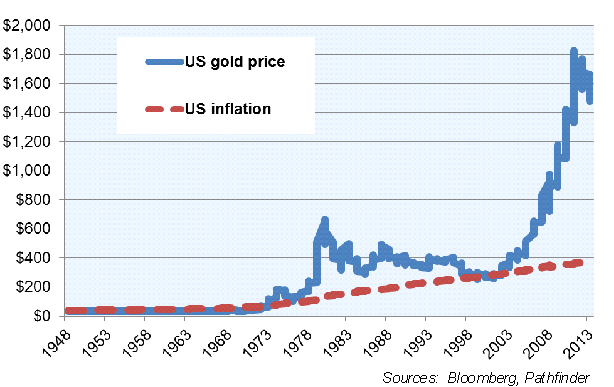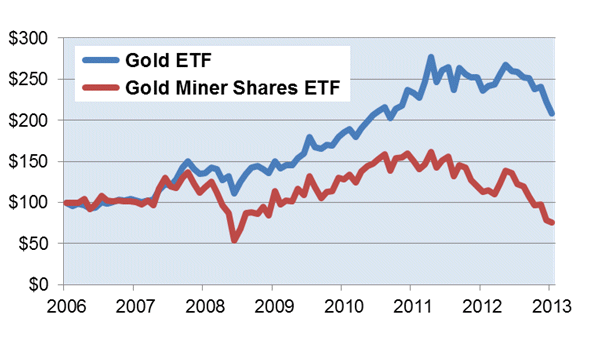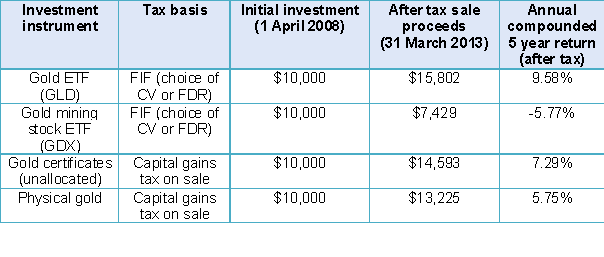Pathfinder: Gold’s glitter – going, going, gone, or has it?
In this month's commentary John Berry at Pathfinder looks at gold and where it fits in as an investment now the bubble has burst.
Tuesday, July 2nd 2013, 9:30AM  7 Comments
7 Comments
by Pathfinder Asset Management
Gold surged from US$255 in April 2001 to a high of US$1,913 in September 2011 (that’s over 20% p.a. compounded for a decade!). It has since lost its shine and retreated about 35%. The market sell-off included a monumental 13% free fall over 2 days in April – you have to go back 30 years to see this rate of wealth destruction in gold markets. This article is an overview of gold investing – most of which is widely known – but note in particular the application of capital gains tax rules (in paragraph 5 below).
1. Gold – from a “gold bug” perspective
Gold has long been recognised as a “store of value” and a “medium of exchange”, i.e. as a currency. The Kingdom of Lydia (located in modern day Turkey) is thought to have been the first to mint gold coins around 650 BC.
Supporters of gold hold it out as an inflation hedge – this was particularly true until the “gold window” (ability to freely convert the US dollar into a fixed amount of gold) was closed by President Nixon in 1971. Since the 1970s the investment return from gold has exceeded inflation (see graph below) but it can hardly be called an “inflation tracker”. It is clearly volatile and can trend (up or down) for a decade or more.

Gold is also seen as insurance against financial catastrophe, particularly the risk that fiat currencies become worthless. Given its historical importance, fungible properties, restricted supply and global recognition – the insurance argument seems reasonable. Just how much it should make up of an investment portfolio is another question entirely.
2. Gold – from a “greater fool” perspective
Gold has inherent beauty and value - but its beauty and value are definitely in the eye of the beholder. From the 7th century to the 14th century Africans (in what is now Ghana, Mali and Sudan) were bemused by the European and Arab fascination for gold – and happily traded their gold for an equal weight of salt. To them a life sustaining mineral was of much greater value than a metal used only for adornment.
Gold has some significant drawbacks as an investment. Here’s 3 for starters – (1) it pays no income – in fact you have to pay someone to store it for you (2) there are no reliable metrics to value gold (the value is simply the marginal price a buyer is prepared to pay) and (3) unlike other precious metals there are limited industrial uses for gold (jewellery and investment comprises 89% of gold demand compared to 48% for silver).
If financial stress returns to the global system, gold will likely shine again. It could be a Eurozone breakup, out of control inflation, geopolitical tension or some other financial catastrophe – gold could be good insurance. But a global recovery would not be a happy environment for gold – growth means interest rates move higher and the opportunity cost of holding gold becomes very clear.
3. Accessing gold as an investment
The most common ways to access gold are:
• Physical gold bars or coins
• Gold certificates (allocated or unallocated gold)
• Gold ETFs
• Shares in gold miners
With gold certificates a provider issues you a right to a certain amount of gold that they hold. The actual gold may be specifically allocated to you or it may just be a big unallocated pool for investors. Many NZ investors tap into Australian or Canadian certificates where they may have some form of state guarantee. Tax implications of these are dealt with under paragraph 5 below.
Gold ETFs are along the same lines as unallocated gold but employ a different structure. A listed fund buys a pool of gold and issues shares to investors (the shares are “physically backed” by unallocated gold holdings). The fund buys and sells gold as new units are issued or redeemed – the listed ETF price should therefore track the gold price less management fees. The most popular is GLD – a US$42 billion US listed ETF managed by State Street where gold is held in several (secret) sites – although there is no shortage of conspiracy theorists arguing that a large part of the ETF gold simply does not exist.
Shares in global gold mining companies are a popular way to get gold exposure – but do they behave more like shares than the commodity? Mining company shares often track the gold price to a reasonable degree – but at the moment of financial crisis when you really want to rely on them, they tend to behave like a share. A great example was 2008 when global uncertainty hammered gold miner shares along with equity markets generally. See the graph below comparing the US$5 billion gold miner ETF (GDX) with the US$ gold ETF price:
Why can gold miner shares behave differently to the precious metal? They mine gold but they are still a company – (1) they may forward sell gold production and not benefit from price rises or suffer from price falls (2) they may not just dig gold – they can own property, manage service businesses, engage in exploration, mine other commodities etc (3) corporate influences have an impact - leverage, capex and management efficiency and (4) listed shares are affected by equity market sentiment.
4. Tax on Gold ETFs and Gold Mining shares
As they are shares Gold ETFs are taxed under the FIF rules for individual investors – meaning a choice of tax on actual gains (CV) or an assumed 5% income (FDR). So long as you can make the election, you will never be taxed on a gain above 5% in any year. This advantageous tax treatment also applies to shares in international gold mining companies. This is, however, different to the tax on gold itself.
5. Capital Gains Tax (CGT) and gold investing
In NZ we have a “loose” capital gains tax regime for property. If a house or building was bought with the intention of resale then gains are taxable. It’s all about intention at the time of purchase. Financial instruments are the same in this respect as property – if purchased with the intention of resale then capital gains tax could apply. In the case of shares, establishing that they were bought for their dividend income (not capital growth) is helpful to establishing whether CGT should not apply.
Gold as an investment is more of a struggle. The capital gains tax rules applying to property also apply to gold in physical or certificate form. If the gold was bought with the intention of resale then CGT could well be payable on any gain. There is no guidance from the IRD on this, but an investor may be hard pressed to establish a reason for buying gold other than capital gain. There is no yield, there are no dividends – it was clearly not bought for an income purpose.
If you buy gold as an inflation hedge it is likely you are expecting a capital gain and are therefore vulnerable to a CGT claim. Why would you buy gold without expecting a gain? Deflation protection? (Japanese investors may have hoped gold would just hold its value over the last decade). Doomsday protection? (If you hold physical gold to survive a future world ravaged by global financial collapse, as long as you don’t sell before the collapse you probably won’t trigger CGT).
The point of raising this is that investors and advisers should be aware capital gains tax may apply to gains on physical or certificated gold. The purpose of purchase is likely to determine whether CGT applies – if an investor buys expecting a capital gain then look out!
6. Returns from gold investments
So how has gold performed as an investment after tax? Well that depends on what period you held for and how you accessed gold. We look below at after tax returns over 5 years investing in gold through a gold ETF (GLD), gold mining stocks represented by a gold miners ETF (GDX), allocated gold certificates and holding physical gold. We assume the $10,000 was invested for 5 complete tax years (1 April 2008 to 31 March 2013) and then realised:

The 5 year returns vary widely. The Gold ETF benefited from FIF tax as opposed to CGT on physical gold and gold certificates (note if CGT was not paid then gold certificates would have returned 10.39% pa and physical gold would have returned 8.49% pa). Gold mining stocks “blew up” compared to gold in 2008 and have not recovered – and so produced significantly lower (and negative) returns.
Note that our calculations include an allowance for transaction costs and that none of these are NZ dollar hedged (in each case the strength of the NZ dollar has had a negative return impact). Physical gold struggled vs the Gold ETF because of transaction costs – the buy/sell spreads for physical gold we were quoted by two NZ based bullion dealers each ranged 9%. This means if you invested $100 and immediately sold without the market price changing you were returned $91. That is the cost of having physical gold rather than gold in the form of a financial instrument. Assuming this is properly disclosed to investors, it is for them to decide if the potential benefit exceeds the cost.
7. Final thoughts
What does this tell us? Everyone has their own ideas on gold as an investment – below are some points to ponder:
Same exposure but different outcomes: Where different investment instruments are available to access the same investment, do consider the different transaction costs and tax treatment. These can make a significant difference to returns for physical gold vs Gold ETFs vs gold miner shares vs physical gold.
Challenge accepted thinking: Most investors and advisers do not pay tax on physical or certificated gold. The general hope is “safety in numbers” with this approach. We question this thinking – as CGT probably does apply – do the research. If you buy physical or certificated gold for a reason other than price appreciation, then make a file note recording this.
When a precious metal behaves like a share: Many investors want gold exposure as “insurance” against global financial crisis. They may also use gold mining shares as a proxy for gold returns. But take care - the moment you want to call on the insurance the mining shares may behave like equities and not gold. Gold shares may not shine at the very moment you need them most.
John Berry
Executive Director
Pathfinder Asset Management Limited
Pathfinder is an independent boutique fund manager based in Auckland. We value transparency, social responsibility and aligning interests with our investors. We are also advocates of reducing the complexity of investment products for NZ investors. www.pfam.co.nz
| « Equities OK for income: Pengana | Hamish Douglass Unplugged - Latest Video from Adviser Briefing - August 2012 » |
Special Offers
Comments from our readers
Mike, if you buy physical gold as a currency to use in a world after a financial meltdown, then I can understand your point that return on gold doesn't necessarily matter for you. But if you include gold in a portfolio to help smooth volatility and improve return (i.e. your points (1) and (2)) then I am not sure how to measure its contribution to the portfolio if you can't measure return via its change in price less transaction costs.... You must also select a fixed time period to measure this return. Can you please elaborate on why this is a "classic mistake"?
For the record there is no science behind the 5 year period I chose - other than wanting a period where the CV / FDR rules had applied (ie post 2007).
Thanks.
The price of Gold is determined by the balance between two elements (i) actual supply and demand, and (ii) speculative frenzy. Given that supply of actual gold is very restricted, then there should theoretically be a long term increase in price as the number of people able to buy gold in places like India increases. However speculative frenzy dominates short term, so it is very difficult to say what the price would be if that speculation did not exist.
Within a portfolio the actual return on an individual asset is irrelevant. What is important is how it affects the overall portfolio return and fluctuation. In that sense Gold's useful characteristic is its correlation to a generalised portfolio, not its return (which disappears inside 100 other assets). It is useful to note, however, that Gold only increase in price in a crash because people expect it to - its a group think illusion, with no guarantee of repeating in the next crash. If you look at past crises Gold has not risen every time.
The characteristics of products like Gold ETFs or Gold Mining Shares are another story.
Also, given the volatility of the NZD/USD exchange rate and the marked decline of the gold price in April, is it possible to show how significantly the relative 5-year returns (in NZD) have changed by, say, 30 June 2013?
Sign In to add your comment
| Printable version | Email to a friend |










In fact while Gold is high risk, it has two useful characteristics (1) high price fluctuation - so there is always a chance of gain from smart speculation, (2) a low correlation to the rest of the market - thus it can be useful within a portfolio as it can cut portfolio fluctuation.